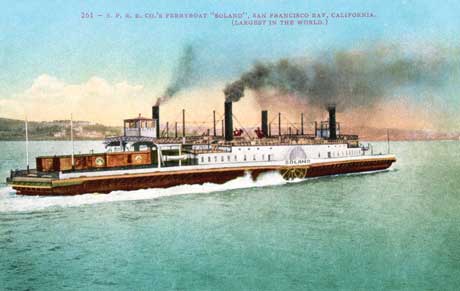
History of the Depot
Arthur Brown, Senior
Doug Offenbacher
The name Arthur Brown has come up before in these columns and justifiably so. He was the Superintendent of Buildings and Bridges for the Southern Pacific Railroad, responsible for all such construction throughout the entire network of associated railroad companies. A most talented architect and civil engineer.
We’ve also discussed his son, Arthur Brown, Junior, one of San Francisco’s most noted architects with a long list of credits including San Francisco City Hall. While Arthur Junior achieved the greater fame, a conversation with Jeffrey Tillman, professor of architecture at the University of Cincinnati and biographer of Arthur Junior, left me with great respect for Arthur Senior as well.
Working in the shadow of the Big Four, Arthur Senior not only shaped the architectural and structural signature of a railroad empire, he set the standards for all who followed. His was the ingenuity that enabled many of the accomplishments still marveled at today.
 |
One of those marvels was the Ferryboat Solano, the largest ferry in the world. Crossing the bay was an obstacle of no small proportion to Sierra-bound rail traffic. So Arthur Brown built a ferry, a very big ferry capable of carrying 24 passenger cars or 48 freight cars plus a locomotive. Between docking slips in Benicia and Port Costa where the current was eight miles per hour and the tidal swing as much as eight feet, Arthur Brown’s magnificent Solano provided safe, efficient crossings from 1879 to 1930 when a drawbridge was constructed from Martinez.
When snow slides threatened the crossing of the Sierra, Arthur Brown, with a crew of 2,500 Chinese workers, designed and built snow sheds over thirty-seven miles of track to keep them clear. It was a three year project at a cost then of $2,000,000 and 65,000,000 feet of 12” x 14” timbers – an unprecedented engineering feat that has since been replicated on rail lines in mountainous regions around the world.
When Charles Crocker and Leland Stanford built their massive mansions at the top of Knob Hill, it was Arthur Brown who supervised the construction, after first designing the critical system of retaining walls that would assure they remained firmly at the top.
When Charles Crocker and his Pacific Improvement Company bought the 7,000 acre Del Monte Forest and Pebble Beach in 1880, it was Arthur Brown to whom they turned to design and build the luxurious Del Monte Hotel, considered the finest seaside resort in the world.
When Leland and Jane Stanford brought Boston architect Charles Coolidge to California to design the buildings of Stanford University, Arthur Brown was charged with overseeing all construction phases, working closely with Coolidge. According to Professor Tillman, the two formed a close friendship that continued long after the Stanford project.
Certainly Arthur Brown, Sr. was a man of great ability and deserving of his every tribute, but the primary reason for bringing him up is my growing belief that the mystery architect who created the plans for our depot and our sister in San Carlos was, in fact, Arthur Brown, Sr.
Not to say his new best friend, Charles Coolidge had no hand in the process; it’s obvious there was direction from a master of Richardsonian styling, but there are also deviations from Richardson’s classic simplicity, especially in the detailing. We’ll look closely at the depot in a future column with some expert assistance. Meanwhile, why not take a walk and take a close look for yourself? I think you’ll be surprised how much you’ll discover.
Articles
1. A Quiet Treasure1. Kenwood Depot 125 years of stone standing strong
2. Does the Depot Have a Twin?
3. An impressive family tree
4. Tales and tangents
5. The west was young
6. Charles Allerton Coolidge
7. N.W. Griswold
8. T. J. Ludwig
9. Mark McDonald
10. Some Additions
11. Arthur Brown, Senior
12. Marketing Los Guilicos
13. Discovering Our Sister Station
14. History of the San Carlos Depot